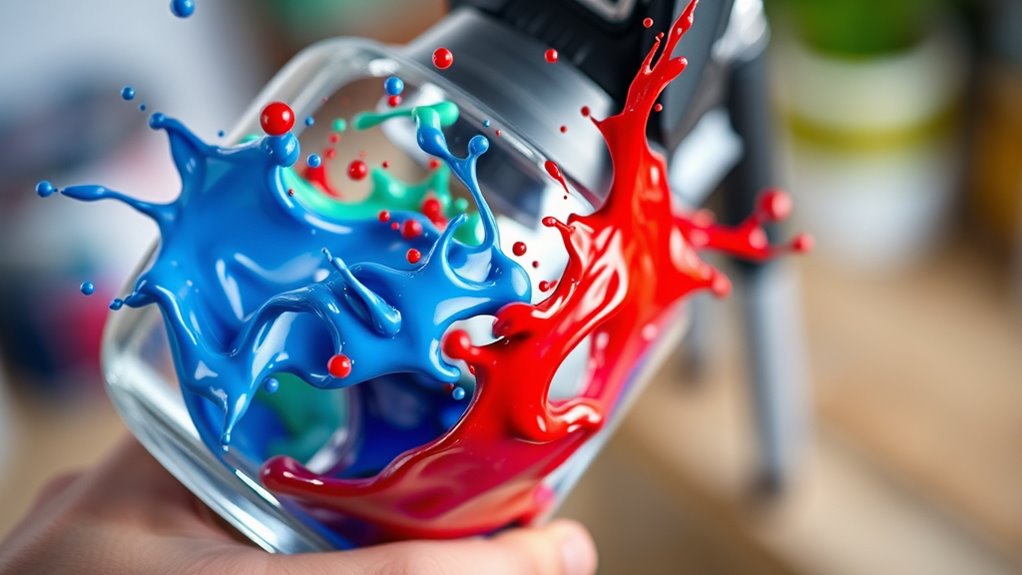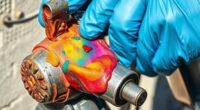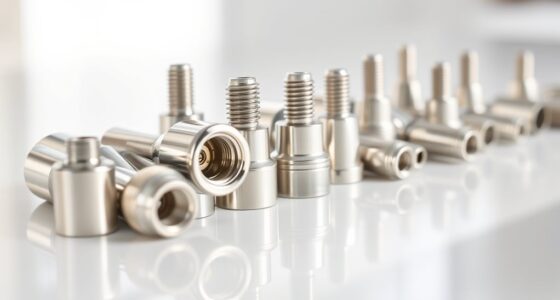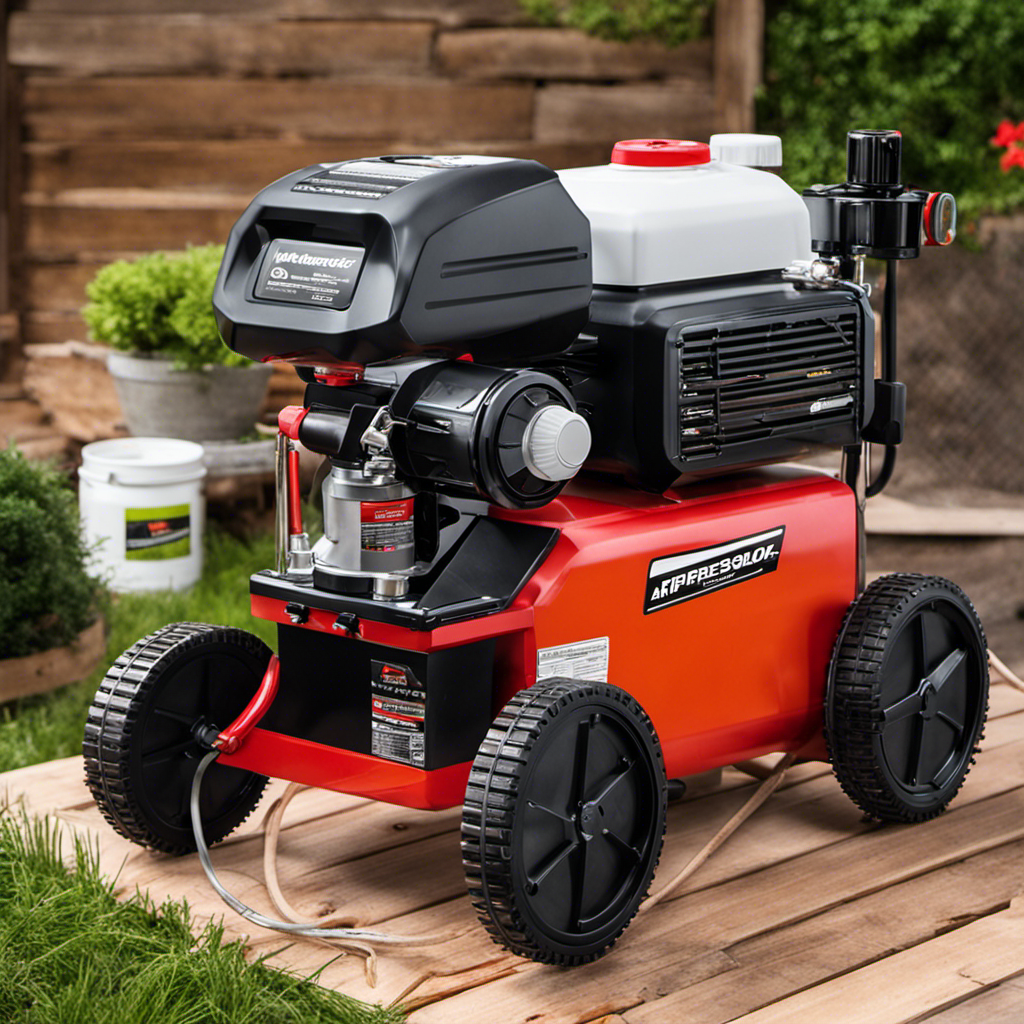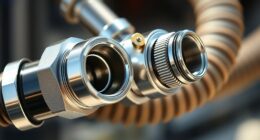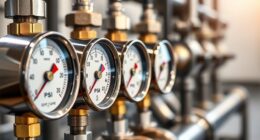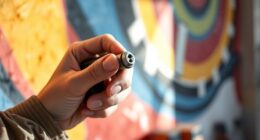Not all paints need to be thinned before spraying, but many do to achieve a smooth, even finish. The need depends on your paint type, sprayer specifications, and manufacturer recommendations. Thinning helps prevent clogs, uneven patterns, and drips, especially with thick primers or paints. Testing on scrap surfaces and adjusting the mix guarantees the best results. Keep exploring to discover tips that can make your spraying projects easier and flawless.
Key Takeaways
- Thinning depends on paint type and sprayer specifications; not all paints require thinning.
- Check the manufacturer’s recommendations and test on a scrap surface to determine if thinning is needed.
- Thick paints or primers often need thinning for smooth spraying and to prevent blockages.
- Paints designed for spraying typically do not require thinning, while others may benefit from it.
- Proper thinning improves spray pattern, finish quality, and reduces issues like sputtering or clogs.
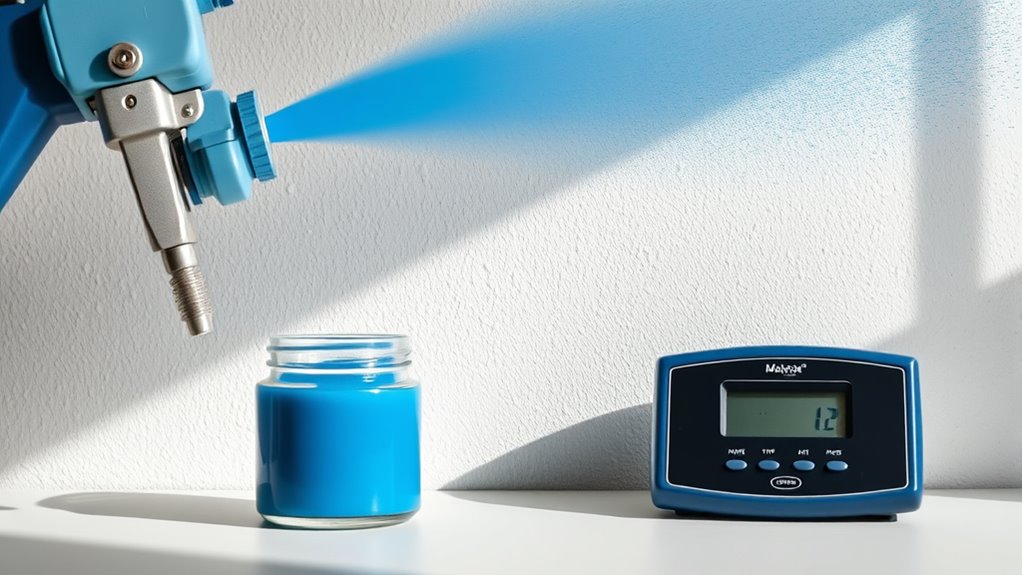
Do you need to thin all paints for a paint sprayer? Not necessarily. The need to thin depends on the type of paint you’re using and the sprayer’s specifications. Thinning is essential when the paint’s consistency is too thick for proper atomization, which can cause uneven spraying, drips, or clogged nozzles. Before you start, check the paint manufacturer’s recommendations—some paints are formulated to be sprayed straight from the container, while others require thinning for ideal results. Keep in mind that using the right brush techniques during application can also influence the finish and adhesion, but when it comes to spraying, proper thinning ensures smoother application and avoids frustrating blockages. Additionally, understanding the paint formulation can help determine if thinning is necessary for optimal spraying performance. Your choice of primer compatibility is another vital factor. Some primers are thick but designed specifically for spray applications without thinning. Using incompatible primer or trying to spray a thick primer without proper thinning can lead to poor adhesion and uneven coverage. Conversely, if your primer is too thin, it may not provide the necessary base for your topcoat. Always verify whether the primer you’re using is compatible with your sprayer and whether it needs thinning for better flow. Thinning primers can improve their sprayability, especially when working on larger surfaces or detailed areas where controlled application matters. When it comes to brush techniques, they’re more forgiving of thicker paints since you’re applying the paint directly with a brush or roller. Spray painting, however, demands a paint with the right viscosity for the equipment. If the paint is too thick, you might experience sputtering or uneven spray patterns, which can be frustrating and time-consuming to fix. Proper thinning helps achieve a consistent spray pattern, giving you a smooth, professional-looking finish. Always test the paint on a scrap surface first, adjusting the thinning ratio as needed, until you find the right flow.
Frequently Asked Questions
Can I Use Leftover Paint Directly in My Sprayer?
You can use leftover paint directly in your sprayer if it’s compatible and properly mixed. First, do some paint mixing to ensure even consistency. Check your sprayer’s compatibility because thick or old paint may clog or damage it. If the leftover paint is too thick, thinning it slightly improves application. Always strain the paint to remove debris, and test spray on a small area before starting your project.
How Do Temperature and Humidity Affect Paint Thinning?
Imagine you’re about to paint, and suddenly, the weather shifts. Temperature and humidity are environmental factors that directly impact your paint consistency. Hot, dry conditions can cause paint to thicken, while high humidity might make it too runny. You’ll need to thin your paint accordingly, ensuring smooth application. Always consider these environmental factors, as they can change how your paint flows and adheres, affecting your overall finish.
Is There a Difference Between Thinning for Indoor and Outdoor Paints?
You might notice a difference between thinning indoor and outdoor paints because of their unique formulations. Indoor paints often require less thinning to maintain proper paint consistency and guarantee smooth application, while outdoor paints may need more thinning due to thicker formulations designed for durability. Always consider your surface preparation and follow the manufacturer’s recommendations for the best results, adjusting the thinning process as needed for ideal coverage.
What Are the Risks of Over-Thinning Paint?
Did you know that over-thinning paint can lead to up to 30% more drips and runs? Over-thinning risks ruining your project by compromising paint consistency and causing equipment clogging. When paint is too watery, it won’t adhere properly or provide a smooth finish, and it can damage your sprayer. Always check compatibility and follow recommended thinning guidelines to avoid these issues and guarantee a flawless application.
How Often Should I Clean My Sprayer When Using Thinned Paint?
You should clean your sprayer after every use to maintain proper sprayer maintenance and guarantee paint consistency. Regular cleaning prevents clogs and buildup, especially when using thinned paint. If you’re switching colors or types of paint, clean it thoroughly to avoid contamination. Even if you’re using the same thinned paint, a quick rinse helps keep your sprayer in top shape, ensuring smooth operation and professional results each time you spray.
Conclusion
In the end, not every paint demands a delicate touch of thinning, much like knowing when to let things flow naturally. By paying attention to the paint’s consistency and your sprayer’s whispers, you’ll find the sweet spot that makes your project sing. Trust your instincts and test a small amount first—sometimes, a gentle nudge is all it takes to keep the process smooth and your finish flawless.
Franz came aboard the Paint Sprayer Zone team with a background in both journalism and home renovation. His articulate writing style, combined with a passion for DIY projects, makes him an invaluable asset. Franz has a knack for breaking down technical jargon into easy-to-understand content, ensuring that even the most novice of readers can grasp the complexities of paint sprayers.
